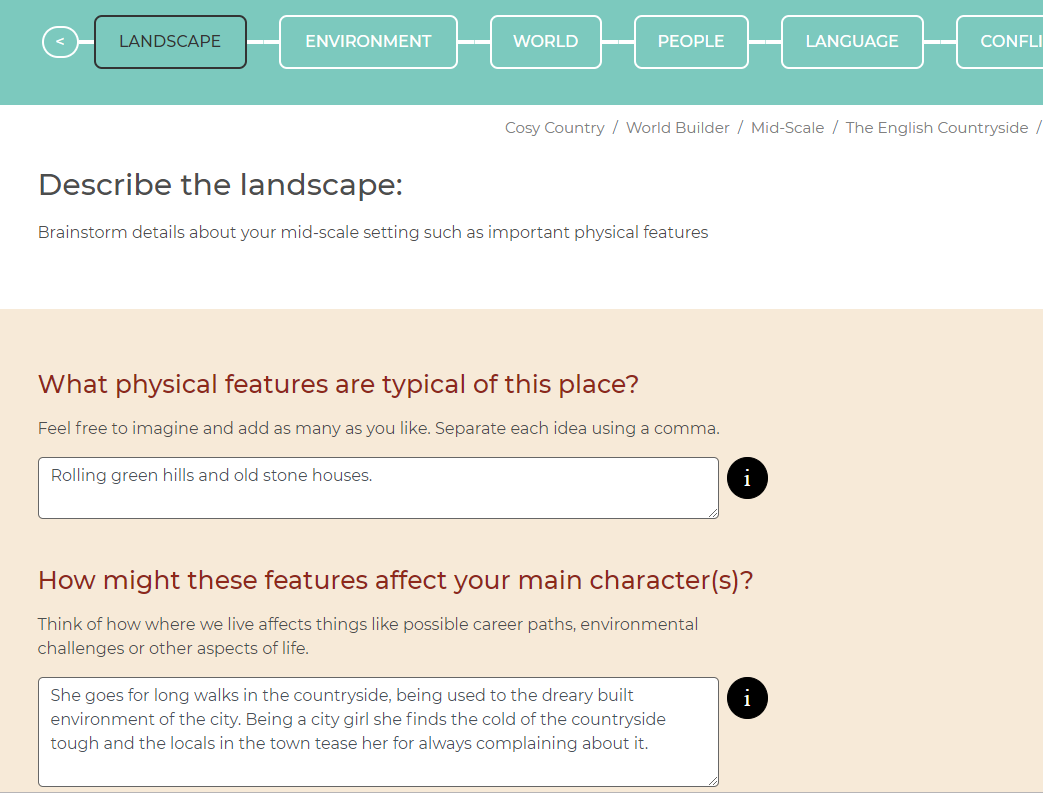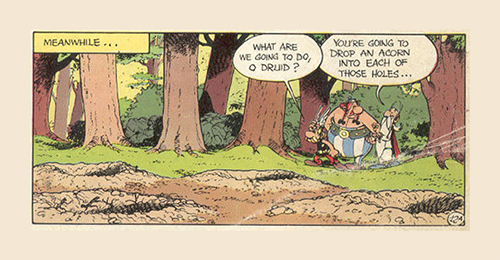In epic fantasy world building, natural environments provide possible hazards (freezing cold, dangerous volcanoes) and mood or atmosphere. Even in ‘realist’ fiction set in our own world, environment (such as the details that make a coastal city familiar, for example), is a key part of setting. Read tips for creating an engaging natural world for your story:
First: Why ask world building questions about environment?
The natural world, from plant and animal life to geology, affects our lives. It shapes everything from what we can eat (what can grow or is more accessible than other food stuffs) to where we can go. Especially in settings where technology isn’t powerful enough to give characters the means to overcome geographic limitations easily. For example, a setting without cars or air travel.
The natural environment is omnipresent in the history of myth and storytelling.
Take, for example, the Greek myth of Persephone. The King of the Underworld Hades snatches Persephone from her mother Ceres, the Goddess of agriculture and fertility, to be his bride. This is a tale explaining the origins of seasonal change. Although Ceres recovers her daughter, Hades keeps Persephone for a few months each year. This is when winter arrives, due to Ceres’ sadness at her daughter’s absence. She neglects her crops as she pines for her daughter.
Looking past mythology to literal uses of natural environment in stories, rivers are places of adventure in novels like Mark Twain’s Adventures of Huckleberry Finn (1884). Or treacherous sites of personal tragedy in novels like Faulkner’s As I Lay Dying (1930). Mountains may be mysterious, mythological places, as in the central chapter of David Mitchell’s Cloud Atlas (2004). Or they may be arduous, challenging summits in adventure stories.
In short, the natural environment in a story can provide interesting obstacles, mysteries, explanations, themes and symbols. It can shape what your characters can and can’t do, or where they can and can’t go yet.
When creating natural environment for your story, ask:
1: What are key features of your world’s environment?
The World Builder tool in our story outlining dashboard takes you through step-by-step prompts to find details for your settings. All this information is added in structured sections automatically to your private outline. You can download this any time from your private dashboard.

Gathering these environment details will help you to imagine your story’s natural environment and what role(s) it might play in your characters’ story arcs.
Say, for example, your story traces the lives of farmers in a rural setting. The natural world will likely feature more strongly than if you write a slick legal thriller set in a sprawling city.
Fantasy in particular often features natural, magic-filled environments.
In urban fantasy, however, the built environment replace the more rural, Tolkien-like ‘nature’ of many epic fantasy classics.
Some questions to ask about your world’s natural environment:
In what season does your story take place?
In C.S. Lewis’s The Lion, the Witch and the Wardrobe (1950), for example, the antagonist, the White Witch, has cast a spell plunging the magical realm of Narnia into eternal winter.
Environment (and season) here are environmental signs or shadows of an antagonist’s cold cruelty. C.S. Lewis also uses the symbolism of winter to evoke a sense of death and loss (of cyclical plant life, for example, like in Ceres’ myth).
Thanks to the White Witch, rebirth and renewal are postponed indefinitely. Narnia’s animal inhabitants suffer as a result. This gives the child protagonists a goal – to free the animals from this harsher environment.
Here, season and weather reflect character while also establishing tone and mood for the story.

Do features in the landscape affect your characters’ lives? How?
Perhaps your story will unfold in the shadow of a mountain, on the banks of a river, or in a thriving seaside town. Think about how these large-scale natural features may determine further details about your world (such as its beliefs and customs).
For example, in Greek mythology, the Gods dwell on Mount Olympus. In a pre-modern village in the foothills of a mountain, might the locals share myths involving a nearby, unreachable summit? In stories, mountains have been home to benevolent forces (e.g. Gods), malevolent ones (ancient or modern-day evils and their lairs) and more neutral, elusive mysteries (e.g. the mythological yeti).
You can also use the natural environment in your world building to create tension and major obstacles for your characters. This is common in quest-type stories.
2: What obstacles for characters could your environment create?
Environmental obstacles are staples of quest, adventure and survival narratives.
Let’s consider a classic example from William Faulkner’s acclaimed novel, As I Lay Dying (1930).
The central quest of the novel is the Bundren family’s mission to bury their mother, Addie, in her hometown. They cart her casket through great trials towards Jefferson, Mississippi, their goal destination.
Early in the Bundrens’ quest, heavy rainstorms flood a river they must cross to continue. The flood washes away key bridges, and in the family’s attempt to cross, the father Anse Bundren’s mules drown.
Faulkner uses the natural environment to create obstacles that create narrative tension as well as thematic, plot and character development. Here:
- The environment shows the danger and hardship the Bundren family will face. It shows the courage and commitment they need to reach their goal, raising the story’s stakes
- The river scene adds mythic echoes (for example, the poisonous river Styx that the dead must cross on their way to the afterlife in Greek mythology). This deepens the themes of the novel
- Faulkner uses the environment’s dangers to develop characters: He shows how each of the Bundren children cope, cycling through their points of view. One son, Darl, is fatalistic and dreads the river. Another, Jewel, fights the current in efforts to save their mules and his mother’s casket
Following Faulkner’s example, think about the natural environment and ask some world building questions. For example, what natural threats or challenges might your characters encounter in their surrounds?
3: How do environments in your world contrast or change over time?
The natural environment in fiction often helps to establish a sense of time, place and history.
Often, it underscores historical or social change.
Let’s examine an example from the French satire comic book series, The Adventures of Asterix by Goscinny and Uderzo.
The central conflict and organizing idea throughout the Asterix series is Ancient Rome’s imperialist conquest. It follows a steadfast village of Gauls (ancient inhabitants of what is now France) who resist the Romans’ expansionist greed using their wits and magic.
One book in the series satirizes urban development. Environmental change is a big part of the story.
In The Mansion of the Gods (1971), Julius Caesar attempts to establish a housing settlement for retired Romans in the woods near the Gauls’ village. His aim? To force the Gauls to accept Roman ‘civilization’.
How The Mansion of the Gods uses environment to drive the story
The comic’s creators show the disruptions this process causes, including the environmental devastation in the nearby forest. The Gauls’ way of life is challenged as their food source (wild boar) flees from its natural habitat.

When settlers start arriving at the Mansions, this also disrupts trade and industry in the nearby Gallic village. The village becomes a local tourist attraction for rich retirees. Locals compete for the Romans’ money. Locals resent having to suddenly pay ‘tourist’ prices in their village. The boom pushes prices up, then crashes prices as the market is flooded with similar products competing for the Romans’ money.
Throughout, Goscinny and Uderzo use the natural environment creatively and as an active ‘player’ in the story:
- They show the effects of urban development on the environment, followed by the snowballing social effects of these changes. Indigenous people (the Gauls) pay the price for city-dwellers dreams of idyllic retirement. We see environmental change create dangerous stakes and tensions between different groups
- The creators show how man-made environmental change drives other changes. We see how the economics of the village, locals’ livelihoods, become dependent on the whims of the wealthy retirees
The takeaway from this satire of urban development is that environment profoundly affects ways of life and can directly influence characters’ arcs. Just as the Gauls in Asterix’s village change with their environment, your characters can encounter new obstacles and choices due to a changing landscape. This is particularly common in dystopian novels (such as Cormac McCarthy’s The Road) where environmental destruction limits characters’ choices and options.
4: What symbolic ideas could environment in your story create?
As much as environment is often literal – settings portrayed as real mountains, streams, fields and forests – it also is rich with images that can be read in symbolic, non-literal ways.
For example, in the Arthurian Grail legend about the knight Perceval (written, it’s estimated, between 1135 and 1190), the story begins in the forests of Wales. Perceval’s mother raises him apart from civilization, and when he eventually emerges into the world, he is initially a laughing stock due to his ‘unworldly’ manners and behaviour.
Various writers have examined the image of the forest in Perceval’s story and its symbolism. Some, for example, see it as womb-like. The forest is seen as a symbol of Perceval’s mother’s maternal, protective care. However you read the forest, there is a strong contrast between its innocence and the outside world of experience, and quests, of knights, kings, killings and mystery adventure.
Think about the environmental features of your story and what they might represent (like the death-and-afterlife symbolism of the river in As I Lay Dying).
Join Now Novel and use the World Builder tool to create and link setting ideas and gather them all in your comprehensive, structured story outline.


3 replies on “World building: Writing the natural environment”
Goscinny and Underzo may well have been ahead of their time: I doubt that in 1971 there was much attention paid to issues like urban development and the problems it can create for the natural environment, but they were on to it! I used to love reading Asterix as a child- funny and clever at the same time. Nice article- thank you.
Hi Amanda,
They were indeed! Such brilliant wordplay, too, and the English translations by Anthea Bell were so excellent to be able to capture that too. Thank you for reading our blog 🙂
[…] Ask yourself some of the following questions to get started: […]